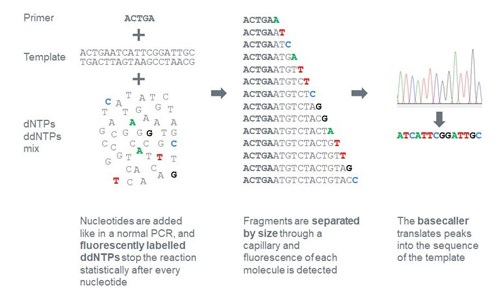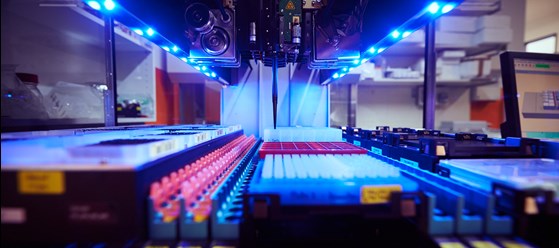Overview - What is Sanger sequencing?
Sanger sequencing, also known as chain-termination sequencing or dideoxy sequencing has been the powerhouse of DNA sequencing since its invention in the 1970s. The process is based on the detection of labelled chain-terminating nucleotides that are incorporated by a DNA polymerase during the replication of a template.
The method has been extensively used to advance the field of functional and comparative genomics, evolutionary genetics and complex disease research. Notably, the dideoxy method was employed in sequencing the first human genome in 2002. Because of its suitability for routine validation of cloning experiments and PCR fragments, Sanger sequencing remains a popular technique in many laboratories across the world.
Applications - What are the advantages of Sanger sequencing?
Sanger DNA sequencing is widely used for research purposes like:
- Targeting smaller genomic regions in a larger number of samples
- Sequencing of variable regions
- Validating results from next-generation sequencing (NGS) studies
- Verifying plasmid sequences, inserts, mutations
- HLA typing
- Genotyping of microsatellite markers
- Identifying single disease-causing genetic variants
Workflow - Sanger sequencing methods & technologies
Dideoxy sequencing is based on synthesis of DNA strands that are complementary to a template DNA strand. The sequencing reaction uses normal deoxynucleoside triphosphates (dNTPs) and modified dideoxynucleoside triphosphates (ddNTPs) for strand elongation. The ddNTPs are chemically altered with a fluorescent label and with a chemical group that inhibits phosphodiester bond formation, causing DNA polymerase to stop DNA extension whenever a ddNTP is incorporated. The resulting DNA fragments are subjected to capillary electrophoresis, where the fragments flow through a gel-like matrix at different speeds according to their size. Each of the four modified ddNTPs carries a distinct fluorescent label. The emitted fluorescence signal from each excited fluorescent dye determines the identity of the nucleotide in the original DNA template.

Sanger sequencing vs. next-generation sequencing
The DNA sequencing field did not stop evolving with the successful adaptation of Sanger sequencing. The establishment of next-generation sequencing (NGS) and third-generation sequencing technologies offered substantial benefits compared to the traditional dideoxy method. However, the chain-termination method remains widely used in the sequencing field, because it offers several distinct advantages. Specifically, Sanger sequencing is preferable over NGS for:
- Sequencing of single genes
- Cost-efficient sequencing of single samples
- Verification sequencing for site-directed mutagenesis or the presence of cloned inserts
- In some cases, analysis of longer fragments (~1,000 bp in length)
- In some cases, less error-prone than NGS
Nevertheless, next-generation sequencing is often considered to be superior to Sanger sequencing, especially for project objectives that require:
- Cost-efficient, simultaneous interrogation of more than 100 genes at a time
- Finding novel variants by increasing the number of targets sequenced per run
- Analysis of samples with low-input DNA
- Sequencing of whole genomes, especially microbial genomes
Often laboratories rely on both Sanger and NGS techniques, where Sanger sequencing is used for more routine small-scale projects and NGS is applied to meet large-scale sequencing Needs.

Scientific expertise: Sanger sequencing
Eurofins Genomics is a leading Sanger sequencing provider. In the past few years, the company’s Sanger services have helped elucidate a wide range of research questions on topics ranging from membrane trafficking to CRISPR interference to tumour mutations to the composition of microbial communities and much more. The company also specialises in custom applications of Sanger sequencing, including:
- PCR establishment with or without primer design
- Cloning
- DNA isolation
- Bioinformatics: SNP/InDel analysis, assembly, mapping
- Genotyping – Determining the genetic variants (SNPs/InDels) of an individual for identity testing, pharmacogenomics, disease screening, population genetics and DNA sample profiling purposes
- Primer walking – for sequencing long DNA templates (up to 7 kb) from end to end by a process that includes several rounds of sequencing, with each round initiated from a new primer based on the previously determined sequence; applications include gap filling, sequencing of large clones and sequence verification
Products related to Sanger sequencing
Eurofins Genomics' Sanger sequencing products can process a variety of starting materials submitted in tubes or plates. Exceptionally high-quality sequencing results are available online.
TubeSeq and PlateSeq services combine highest quality and highest flexibility. Use it to sequence the DNA from all types of sample material, including large constructs. With the TubeSeq service, ordering and re-ordering of up to 8 reactions per sample is possible. The template DNA and ordered primers are also stored for 4 weeks. With the PlateSeq Service get up to 96 sequencing reaction for premixed samples, purified DNA, crude PCR products, or bacterial clones. To guarantee highest quality sequencing of complex sequences with difficult-to-read stretches for instance, choose the PowerRead Upgrade for TubeSeq and PlateSeq.
The Mix2Seq service includes 96 barcoded tubes and lids for convenient Sanger sequencing. Just send us your purified plasmids or PCR fragments premixed with primer in the tubes - there is no online ordering necessary.
Additional services for customised Sanger projects like cloning, DNA isolation, primer design, primer walking and genotyping are also available. Contact us for more information.